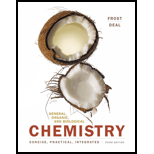
Concept explainers
a.
To distinguish:
Between
Introduction:
Nonpolar molecules are hydrophobic because they usually lack the ability (intermolecular forces) to interact with water molecules. They usually lack the ability to form hydrogen bonds, ionic bonds, or have any sort of dipole interaction with water. Since they cannot interact with water molecules on a molecular level, they tend to stay by other nonpolar molecules (molecules which they can interact with, hence oil and water do not mix very well or at all).
b.
To distinguish:
Between ionic interactions and polar interactions.
Introduction:
Nonpolar molecules are hydrophobic because they usually lack the ability (intermolecular forces) to interact with water molecules. They usually lack the ability to form hydrogen bonds, ionic bonds, or have any sort of dipole interaction with water. Since they cannot interact with water molecules on a molecular level, they tend to stay by other nonpolar molecules (molecules which they can interact with, hence oil and water do not mix very well or at all).
c.
To distinguish:
Between polar and nonpolar amino acids.
Introduction:
Nonpolar molecules are hydrophobic because they usually lack the ability (intermolecular forces) to interact with water molecules. They usually lack the ability to form hydrogen bonds, ionic bonds, or have any sort of dipole interaction with water. Since they cannot interact with water molecules on a molecular level, they tend to stay by other nonpolar molecules (molecules which they can interact with, hence oil and water do not mix very well or at all).
Want to see the full answer?
Check out a sample textbook solution
Chapter 10 Solutions
General, Organic, and Biological Chemistry Plus Mastering Chemistry with Pearson eText - Access Card Package (3rd Edition)
- Complete degradation of a protein into individual amino acids involves choose all that are correct: a. Removal of a water molecule from between two amino acids b. Addition of a water molecule between two amino acids c. A hydrolysis reaction d. The breaking of peptide linkagearrow_forward22-30 (a) Use the three-letter abbreviations to write a representation of the following tripeptide: (b) Which amino acid is at the C-terminal end, and which is at the N-terminal end?arrow_forwardDraw the structure for the dipeptide Ala-Gly. How is this dipeptide different from the one in problem 59?arrow_forward
- Chemistry: Matter and ChangeChemistryISBN:9780078746376Author:Dinah Zike, Laurel Dingrando, Nicholas Hainen, Cheryl WistromPublisher:Glencoe/McGraw-Hill School Pub Co
 Chemistry for Today: General, Organic, and Bioche...ChemistryISBN:9781305960060Author:Spencer L. Seager, Michael R. Slabaugh, Maren S. HansenPublisher:Cengage Learning
Chemistry for Today: General, Organic, and Bioche...ChemistryISBN:9781305960060Author:Spencer L. Seager, Michael R. Slabaugh, Maren S. HansenPublisher:Cengage Learning Introduction to General, Organic and BiochemistryChemistryISBN:9781285869759Author:Frederick A. Bettelheim, William H. Brown, Mary K. Campbell, Shawn O. Farrell, Omar TorresPublisher:Cengage Learning
Introduction to General, Organic and BiochemistryChemistryISBN:9781285869759Author:Frederick A. Bettelheim, William H. Brown, Mary K. Campbell, Shawn O. Farrell, Omar TorresPublisher:Cengage Learning  Introductory Chemistry: A FoundationChemistryISBN:9781285199030Author:Steven S. Zumdahl, Donald J. DeCostePublisher:Cengage Learning
Introductory Chemistry: A FoundationChemistryISBN:9781285199030Author:Steven S. Zumdahl, Donald J. DeCostePublisher:Cengage Learning World of Chemistry, 3rd editionChemistryISBN:9781133109655Author:Steven S. Zumdahl, Susan L. Zumdahl, Donald J. DeCostePublisher:Brooks / Cole / Cengage Learning
World of Chemistry, 3rd editionChemistryISBN:9781133109655Author:Steven S. Zumdahl, Susan L. Zumdahl, Donald J. DeCostePublisher:Brooks / Cole / Cengage Learning Introductory Chemistry: A FoundationChemistryISBN:9781337399425Author:Steven S. Zumdahl, Donald J. DeCostePublisher:Cengage Learning
Introductory Chemistry: A FoundationChemistryISBN:9781337399425Author:Steven S. Zumdahl, Donald J. DeCostePublisher:Cengage Learning





